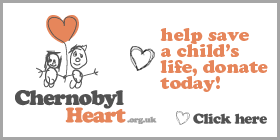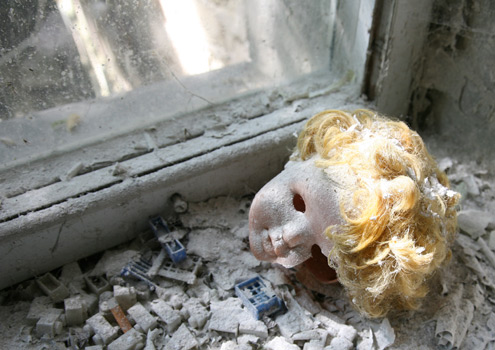Chernobyl, site of the world’s worst nuclear disaster
Chernobyl and Pripyat: after the Wormwood nuclear holocaust
I’m not really sure what I expected of my trip to Chernobyl. I’d read plenty about the subject for many months before my eventual arrival in the Ukrainian capital Kiev, weighed up time and again the moral and safety issues and ultimately decided to take the plunge. The world’s worst nuclear disaster was, ironically, the result of a completely unnecessary safety test. It was the night of 25th April, 1986, and reactor number 4 at the electricity-producing Chernobyl power plant in northern Ukraine was scheduled to be shut down for routine maintenance. The workers made the fatal decision to see if, in the event of a shut down, enough electricity would remain in the grid to power the cooling system for the reactor core; they thus turned off the emergency cooling system.
The carnage that ensued was the result of a culmination of factors, including a design flaw in the type of RBMK reactor at Chernobyl, operational errors and safety procedures which were at best not adhered to and at worst totally ignored. What resulted was a power surge, which in turn led to a massive escape of steam triggering a full-blown nuclear explosion. At 1:26 on the morning of 26th April, 1986, the reactor’s 500-tonne top was breached by a huge fireball discharging nine tonnes of radioactive material into the atmosphere, more than ninety times the amount released in the Hiroshima bomb. The deadly radiation cloud, rich in Cesium-137 and strontium-90, was blown north and west over the next few days, falling patchily over Kiev, but mainly Belarus. In typical Soviet style, the problem was not reported and May Day celebrations continued on the streets of the Ukrainian capital and, terrifyingly, in the impossibly dangerous Chernobyl area, in particular the Soviet model town of Pripyat, within spitting distance of the stricken reactor. It was only when the poisonous radiation clouds were detected as far north as Scandinavia that Swedish scientists alerted the world and the USSR had to come clean.
For too many, by this time it was too late; two people had been killed in the accident itself, but 29 brave firemen were sent in to extinguish the blaze and had neither knowledge of or protection from what they were dealing with. Each had perished horribly and agonisingly within six weeks. Some 135,000 souls were evacuated ‘temporarily’ from Pripyat without any belongings; they have never been able to return.
The long term effects of the disaster are still being evaluated. The most obvious impact has been a massive increase in cases of thyroid cancer in young children, mainly due to the fact that their cells are still dividing and, as they grow, their bodies absorb radioctive substances which mimic essential calcium. The number of extra cases is thought to be around 2,000. Of the 600,000 ‘liquidators’ sent in to clean up, more than 4,000 have died from exposure to radiation, and a further 170,000 have developed other fatal diseases.
Furthermore, some 35,000 square kilometres of forest have been contaminated, leading to unacceptably high radiation levels in meat, milk, vegetables and fruit. The most dangerous foodstuffs are berries and mushrooms. Silt carried down the Dnipro river is highly radioactive, although it’s almost impossible to measure constant levels precisely. Birth defects, suicides and deaths from heart disease and alcoholism are exceptionally high, and by 2015 it is estimated the ‘accident’ will have cost the economy in excess of $200 billion.
It was as late as the year 2000 that the last working reactor at Chernobyl, number 3, was finally decommissioned and shut down. Number 4 is still a deep, dark, threatening ghost, ‘a monster which is always near’ according to one of the 8,000 scientific staff and monitors who travel to the site on a daily basis from the new town of Slavutych. In the months that followed the explosion, the destroyed reactor and over 180 tonnes of radioactive chunks were hastily covered over with a concrete and steel sarcophagus.
In the intervening years, some 350 ardent locals have moved back into the zone, preferring to take their chances with the silent, unseen spectre of radiation than face life in the crowded tenements they had relocated to. They grow and eat contaminated food in contaminated land, and drink contaminated water, yet they not only survive but thrive. It is almost as much of a phenomenon as the flourishing wildlife inhabiting this unlikely natural haven, almost completely reclaimed by mother nature.
Our visit to this abandoned land wasn’t the easiest trip in the world to organise, but we finally got things arranged through CAM travel company, but it was necessary to arrange an international transfer of the funds in US dollars. We nearly lost our booking, however, when CAM had to pay $48 in fees to their receiving bank and therefore didn’t reserve our places because “the money was not enough”. Given that we’d already sent across almost $700, this was more than a little irritating; all they had to do was ask. But, fortunately, we are clairvoyant and did send that last minute email the week before the tour, just to make sure everything was alright. A little knowledge is a wonderful thing.
The day arrived, and Sergei our driver arrived in his rather battered white volkswagen minibus nice and prompt at only twenty minutes late. This vehicle had certainly seen better days; maybe it wasn’t worth sending anything any newer on repeated trips into the exclusion zones. We were joined on our adventure by four amiable Polish lads and, without further ado, embarked upon our 50 kilometre journey north towards Chernobyl.
A few minutes prior to the first checkpoint, we collected Dennis, our guide for the day. A fairly laid-back chap in his late twenties, he was well used to the daily grind of life in the exclusion zones; he makes the trip around sixteen times a month, getting a thorough health check every June: “so far, so good,” he told us.
Before long we were having our passports examined by the officials at that first checkpoint. This was it then – we were inside the 30 kilometre exclusion zone; no going back now. First stop was the Chernobyl Interinform for a history lesson and a briefing. These are the official offices for research and management of the area and, although fairly utilitarian in look and feel, provide an invaluable base for scientists and officials alike. There is something quietly disconcerting about being asked to sign a disclaimer, promising not only that you’ll abide by all the rules (don’t step where you shouldn’t or do anything you’re told not to) but also that you’ll have no claim against the authorities should ‘your health deteriorate following your visit’ – not quite ‘abandon hope all ye who enter here’ but along the same kind of lines.
Once on the road again, a surprise stop was at the Chernobyl village store. “We don’t stop for lunch until 2.30,” Dennis advised, “so buy your water and beer now.” And that set the tone for what turned out to be very much a lads’ day out; there was much beer drinking (even by the driver, rather worryingly) and a good measure of gallows humour, none of which detracted for one second from the seriousness either of what had happened here twenty-two years earlier, or what we were ourselves undertaking. A brief stop at the firemen’s memorial a little further down the road was a poignant reminder of the tragic consequences of this monumental accident; these men were cast forever in the ore that immortalised them; they were real heroes.
After a brief stop at the ‘ghost village’ – the only one razed completely to the ground in an experiment to stop the spread of radiation – it was onward to the infamous reactor itself, complete with decaying concrete sarcophagus desperately hanging on to its belly full of lethal radioactive left-overs until the new steel structure can be built alongside it and slid into place in 2009. This time it’s supposed to last a minimum of 100 years and a maximum of 300; this is a problem that will never go away.
Unstable it may be, but this sarcophagus is still worth its weight in gold to the surrounding regions. A pause on the way afforded us the opportunity to throw chunks of bread to the two metre catfish, thriving happily in the reactor’s cooling pond; the plethora of flora and fauna which abound throughout all three exclusions zones provide testimony to the fact that this apocalyptic nuclear disaster was not universally cataclysmic in its effect. It’s an ill wind…
Leaving the destroyed reactor in our wake, we next fetched up at the deserted town of Pripyat. Built in 1970, this settlement was created purely for population by the Chernobyl work force and their families. How achingly tragic it feels to wander through the dilapidated apartments, restaurant, supermarket and kindergarten, with abandoned signs of life apparent throughout – a shoe here, a doll’s head there, but nothing prepares you for the devastated fair ground. How hard it is to imagine that these bumper cars, the swings, the huge ferris wheel, were never actually ridden upon; this fun fair was set to open just five days after the accident. Now it lies empty, rotting, desolate, the big wheel stretching skywards like a huge mechanical cobweb – a timely reminder that this was once a thriving community with a future. Regular readings from Dennis’s dosimeter ranged from 700 microroentgens to a whopping 2,000 in places; permitted background radiation for Kiev is no more than fifty.
One more stop gave us a glimpse of the boat graveyard, littered with vessels far too radioactive to serve, languishing away in their rusty, skeletal state. These were boats that would never sail again.
After a delicious four course lunch at the Chernobyl Interinform, it was back on the road again, through both checkpoints and on to the decontamination chamber, a unit specifically set up to read our radiation levels before leaving the zone. Cleared by officials, all that remained was the ninety minute journey back to Kiev. What a way to spend a Sunday.
Popularity: 3% [?]
You can leave a response, or trackback from your own site.

Got something to say..? Leave your thoughts...
One Response to “Chernobyl, site of the world’s worst nuclear disaster”

- Kiev, Chernobyl and Pripyat: exploring Northern Ukraine
- CNN 30: Were You There? – remembering the past three decades
- Belarusian capital Minsk is Europe’s best value city break
- Simferopol, Yalta, Balaklava and Sevastopol: exploring the Crimea
- Zeegeuzen – a maritime tavern and one of Ostend’s great little secrets














really interesting entry and photos. the clear weather really makes the pictures even more eerie. sad story